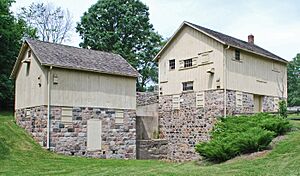Parker Mill facts for kids
Quick facts for kids Parker Mill County Park |
|
|---|---|

Historic grist and cider mills
|
|
| Location | Ann Arbor Charter Township, Michigan |
| Operated by | Washtenaw County |
|
Parker Mill Complex
|
|
| Lua error in Module:Location_map at line 420: attempt to index field 'wikibase' (a nil value). | |
| Area | 11 acres (4.5 ha) |
| Built | 1873 |
| Built by | William Parker |
| Architectural style | Italianate, Log construction |
| NRHP reference No. | 82002888 |
| Added to NRHP | August 4, 1982 |
Parker Mill, also called Parker Mill County Park, is a cool historic spot in Ann Arbor Charter Township, Michigan. It has an old mill and a park. The mill is a great example of how small mills used to work in Michigan. The mill and the nearby Parker House were added to the National Register of Historic Places in 1982.
Today, the mill and the land around it are a public park. The Washtenaw County Parks and Recreation Commission takes care of it. Parker Mill County Park and the Forest Nature Area next to it cover about 45 acres. This area has lots of trees, hiking trails, and a boardwalk for you to explore.
Contents
History of Parker Mill
Early Mills and Owners
Back in 1824, a man named Robert Fleming built a sawmill on this land. It was located on a small hill near a creek, which is now called Fleming Creek. This sawmill was eventually left alone and fell apart.
In 1863, William Q. Parker and his wife Mary bought the land. They were immigrants from England. In 1873, William Parker built the grist mill you see today. It was built right where the old sawmill used to be. Around the same time, he also built a small cabin for mill workers to live in.
Making Flour and Cider
In 1887, William Parker built the cider mill. At first, the Parkers ground flour for their family and their neighbors. They also made their own cider from apples. However, a problem with apple trees in the early 1900s caused them to stop using the cider mill after 1914.
In 1910, William Parker passed away. His son, George Parker, took over running the mill. George started selling products to local stores in Ann Arbor. He used the brand name "Flemings Creek Mills." Soon, the mill became famous for its pancake mix, whole wheat flour, and buckwheat flour.
Changes and Closure
In the 1920s, Geddes Road, which is nearby, was made wider and paved. Because of this, the Parkers had to raise the foundation of the grist mill. George Parker continued to run the mill until he passed away in 1956. After that, the mill stopped its commercial operations.
George's son, Dale, still used the mill to grind flour for his own family. But by 1959, all milling at Parker Mill stopped completely.
Becoming a Park
Soon after the mill closed, the Matthei family bought the farm and mill. At some point in the 1960s, the original dam that powered the mill was washed away.
In 1983, Frederick Matthei sold 26 acres of land around the mill to the Washtenaw County Parks and Recreation Commission. This land included both the grist mill and the cider mill, plus the old cabin. The family sold it for much less than it was worth, which was a kind gesture. The Parker House, which was the family's home, stayed as a private residence.
Washtenaw County worked to fix up the mill. They opened the site as a park in 1984. Since then, the park has grown. New trails have been added, and more things have been put in place for visitors to enjoy.
What You Can See at Parker Mill
The Parker Mill Complex has two main mills: a grist mill and a cider mill. It also has a log cabin where mill workers used to live. The Parker farmhouse is also nearby, but it's a private home and not part of the park.
The Grist Mill
The grist mill was built in 1873. It has three stories and is built into the side of a hill near Fleming Creek. The top floor is made of wood and has special siding called board and batten. The bottom two floors are made of stone. What's really cool is that the mill still has its original machinery inside. And even better, it still works!
The Cider Mill
The cider mill was built in 1887 and is right next to the grist mill. It has two stories. The top story is made of wood, and the bottom is made of stone. Today, the cider mill is used as a small museum. You can learn about how cider was made there.
The Mill-Worker's House
Behind the mills, you'll find a log cabin. This was the house where the mill workers used to live. It gives you a peek into their lives long ago.
Gallery





